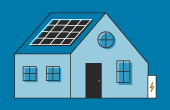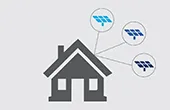Choosing how you want to heat and cool your property is an important decision, especially in regards to energy bills: according to the Department of Energy, heating and cooling make up roughly 48 percent of energy consumption in the average U.S. home. Because these technologies make up such a large portion of energy costs, homeowners are increasingly looking to upgrade to newer, smarter, and more energy-efficient technologies like air source heat pumps (ASHPs). In this article, we’ll dive into some of the most important advantages and disadvantages of ASHPs to keep in mind as you’re evaluating heating and cooling technologies for your property.
Pros and cons of air source heat pumps: overview
There are a number of advantages to installing air source heat pumps over more traditional heating and cooling technologies; however, every property is unique, and heat pumps aren’t the best solution for every building. Here are some of the top pros and cons of air source heat pumps to keep in mind:
Pros and cons of air source heat pumps
| Pros of ASHPs | Cons of ASHPs |
|---|---|
| High efficiency | Higher upfront cost than heating/cooling alternatives |
| May save you money overall on energy bills | Increased electric bills |
| Health and wellness benefits | Susceptible to power outages |
| Heating and cooling system all-in-one | |
| Able to create zones to heat and cool rooms at different temperatures |
Pros of air source heat pumps
There are many benefits to heating and cooling your home with air source heat pumps. Here are some of the most important ones:
ASHPs are efficient (which helps the environment and saves you money)
Air source heat pumps have high efficiencies compared to other heating and cooling technologies; this means that you typically use less fuel to heat or cool your home with ASHPs than you would with more conventional technologies. Over time, consuming less energy can help to reduce both your personal environmental impact and energy bills.
Many heating and cooling technologies run on fossil fuel or electricity produced from burning fossil fuels, which releases greenhouse gases into the atmosphere. When you reduce your property’s fuel consumption, you’re helping to decrease carbon dioxide emissions into the atmosphere and reduce your own carbon footprint.
Additionally, using less fuel helps you save on energy costs. The amount you can save depends on a number of factors, including your existing heating or cooling source, where you live and the cost of fuel in your area. According to research from the Northeast Energy Efficiency Partnerships, property owners who switch to air source heat pumps in the Northeast and Mid-Atlantic regions save roughly $459 annually when compared to electric resistance heaters, and $948 annually when compared to oil furnaces.
ASHPs have a number of associated health and wellness benefits
Have you ever been distracted by a noisy furnace? Compared to other heating and cooling technologies, air source heat pumps operate relatively quietly. This is particularly true if you’re using ductless mini-splits.
Just how quiet are they? Sound is typically measured in decibels (dB): the lower the decibel rating, the quieter the sound. Dishwashers and AC units typically run at around 60 dB. In comparison, many air source heat pumps operate at 40 to 60 dB. Keep in mind that most of this noise comes from the outdoor unit of air source heat pumps; if you install ductless mini splits inside your building, they typically only make between 20 to 40 dB of noise, which is near the sound rating of a whisper.
In addition to increased comfortability from noise benefits, air source heat pumps help improve air quality through air filtration, reducing allergens in the air while heating and cooling your home. They also help to dehumidify your environment, leaving living spaces comfortable.
ASHPs combine heating and cooling systems into one
When you install an air source heat pump, you benefit from the heater and air conditioner in one. This means that you can reduce costs and time associated with installing two different systems that serve separate purposes, as well as lessen the amount of physical space required for two individual technologies.
Cons of air source heat pumps
While there are a number of benefits to using ASHPs, this technology isn’t the best heating or cooling solution for every property. Here are some of the disadvantages of air source heat pumps:
ASHPs can cost more money upfront than more conventional technologies
If you’re looking for the lowest upfront cost as you’re shopping for a heating solution, air source heat pumps likely won’t be it.
The cost of installing air source heat pumps depends on a number of factors, including quality of the equipment, installation complexity, type of system (ducted vs. ductless), and more. Including both equipment and labor, central air source heat pump installations typically cost between $12,000 and $20,000, while ductless systems cost around $3,500 to $5,000 for each indoor unit installed. Gas, electric and oil furnaces, on the other hand, typically cost less than $5,000 to install.
ASHPs may increase your heating costs
While air source heat pumps use less energy and can help many property owners save on heating bills, this isn’t true for everyone. Remember, air source heat pumps require electricity to operate. This means that, even if you use less fuel overall to heat your home with air source heat pumps, you may spend more money on energy bills overall if the cost of electricity in your area is significantly higher than the cost of the fuel you’d otherwise heat your home with. Notably, air source heat pumps will likely save you money if you run your home on oil or propane, but you may initially spend more money heating your home with air source heat pumps if you’d otherwise use natural gas given its current low cost.
ASHPs rely on electricity
ASHPs need electricity to operate. This means that, during grid outages when you lose power, you can’t run your air source heat pumps. However, it’s worth noting that even heating technologies that primarily run on gas (like furnaces or boilers) require electricity to run, even if only minimal amounts.
If you experience frequent power outages, one way to increase resiliency in your home is to install a solar plus storage energy system. That way, you can use solar electricity previously stored in your battery to power appliances (like air source heat pumps) should the grid shut down.
Pair your heat pumps with solar panels
The best way to save on heating and cooling bills is to install air source heat pumps with a solar energy system. By pairing the two technologies together, you can run your ASHPs on free, clean electricity generated right at your property. When you join the EnergySage Solar Marketplace, you can receive up to seven solar quotes from local installers. If you’re interested in pairing your solar energy system with new air source heat pumps, simply note it in your account so that installers can quote the appropriate sized solar panel system for your anticipated electricity needs.






